Aruba Certified Switching Professional Exam Questions and Answers
What is a concept associated with PIM sparse mode (SM)?
Which protocols are used by NetEdit to interact with third-party devices? (Choose two.)
A company requires access by all users, guests, and employees to be authenticated. Employees will be
authenticated using 802.1X, whereas guests will be authenticated using captive portal. Which type of
authentication must be configured on an AOS-CX switch ports where both guests and employees connect?
An administrator wants to implement dynamic segmentation policies. The network consists of AOS-CX and Aruba gateways.
Which type of forwarding should the administrator implement for users that already connect via wireless, but will also be connecting on Ethernet switch ports?
Examine the AOS-CS switch output:
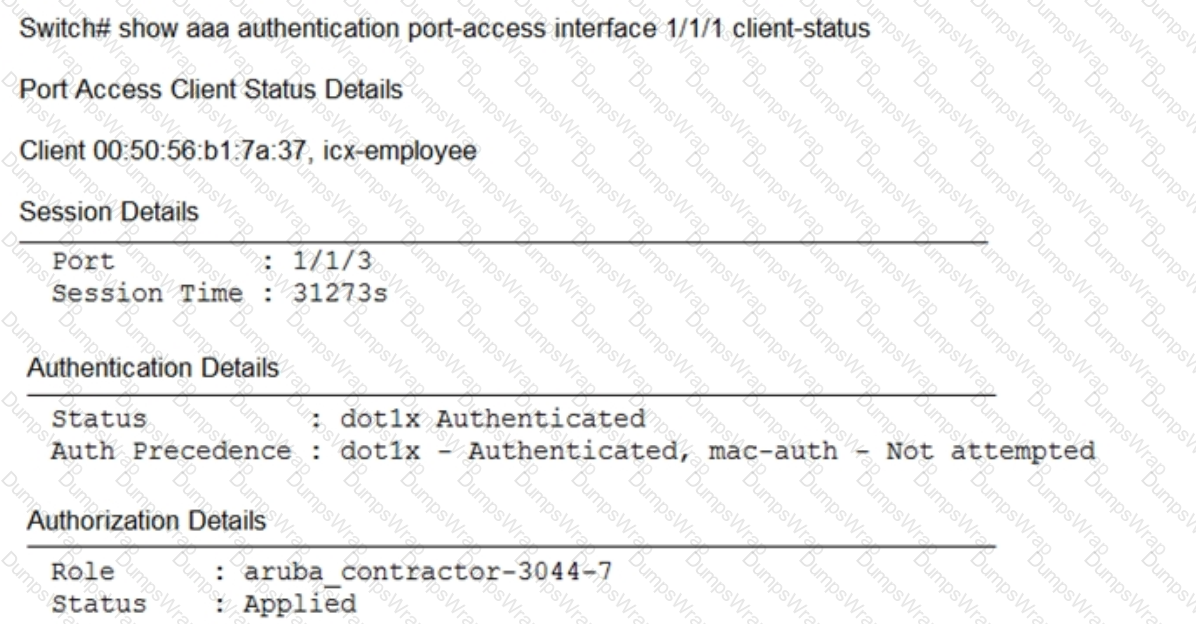
Based on this output, what is correct?
A company has a few servers in a secure, remote location storing highly-confidential documents connected to two AOS-CX 6400 switches configured in a VSX pair The AOS-CX switches perform access control with 802 1X and will be implementing user-based tunneling (UBT) so that Aruba gateway application inspection and stateful firewall policies can be applied to the traffic. The gateways are running version 84 and implement the AP, PEF, and RFP licenses
Which licensing is needed for the two AOS-CX switches?
A company uses NetEdit to manage a network of 700 AOS-CX switches and approximately 1,000 other SNMP-capable devices.
Which management solution should the company use to monitor all the devices, as well as see a topology picture of how all the devices are connected together?
An administrator is supporting a network with the access layer consisting of AOS-CX 6300 and 6400 switches. The administrator needs to quickly deploy Aruba IAPs and security cameras in the network, ensuring that the correct QoS and VLAN settings are dynamically applied to the switch ports. Currently, switches are not configured to do device authentication, and no authentication server exists in the network.
Which AOS-CX feature should the administrator use to dynamically assign the policy settings to the correct switch ports?
Examine the commands entered on an AOS-CX switch:
What is true regarding this configuration for traffic received on interface 100?
An administrator will be deploying NetEdit to manage an Aruba solution. What does NetEdit support?
An administrator wants to drop traffic from VLAN 6 (10.1.6.0/24) to VLAN 5 (10.1.5.0/24), but allow all other traffic. What is correct configuration to accomplish this?
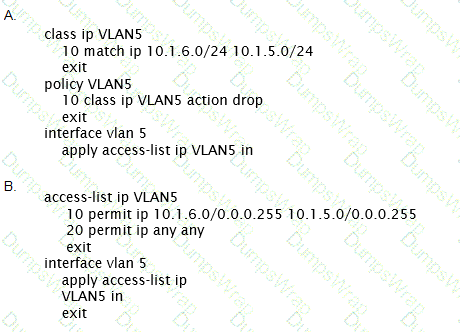
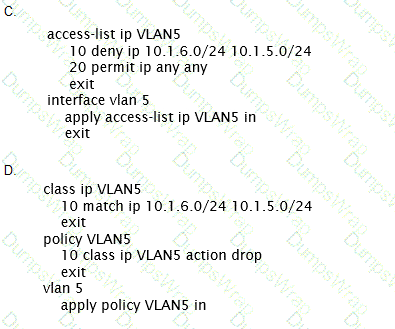
What is required when implementing captive portal an AOS-CX switches?
Examine the configuration of Core-1 and Core-2. AOS-CX switches configured as a VSX stack:
Core1: Interlace lag 256
no shutdown
no routing
vlan trunk allowed all
lacp mode active Interface 1/1/46
no shutdown
lag 256 Interface 1/1/47
no shutdown
lag 256
VSX
Inter-switch-link lag 256
vsx-sync vsx-global
exit
Cofe2: interlace lag 250
no shutdown
no routing
vlan trunk allowed all
lacp mode active
Interlace 1/1/46
no shutdown
lag 256 Interface 1/1/47
no shutdown
lag 256 vsx
inter-switch-link lag 256
exit
When using the "show vsx status" command, the two switches fall to connect and successfully synchronize. What should the administrator do to fix this issue?
A network administrator is managing a network that deploys a multicast service. The administrator has
multiple streams successfully being routed by PIM-DM in the network. The administrator then adds a new stream with a destination address of 239.0.0.1. However, clients who have not joined the stream are receiving it.
What should the administrator do to fix this problem?
A company has an existing wireless solution involving Aruba APs and Mobility controllers running 8.4 code.
The solution leverages a third-party AAA solution. The company is replacing existing access switches with AOS-CX 6300 and 6400 switches. The company wants to leverage the same security and firewall policies for both wired and wireless traffic.
Which solution should the company implement?
A network administrator is implementing OSPF, where there are two exit points. Each exit point has a stateful, application inspection firewall to implement company policies.
What would the best practice be to ensure that one firewall will see both directions of the traffic, preventing asynchronous connections in the network?
MAC authentication is enabled on port 1/1/27 of an AOS-CX switch. The following MAC addresses are defined on the AAA server:
* 88:3a:30:97:b6:00
* 00:50:56:b1:fc:9b
Examine the AOS-CX switch output:
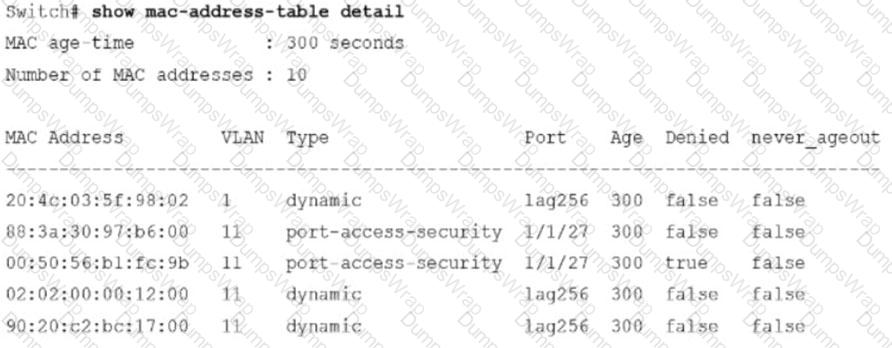
Based on this information, what is true concerning port 1/1/27?
What is correct regarding the operation of VSX and multicasting with PIM-SM routing configured?
Examine the VSX-related configuration of the core layer AOS-CX switch:
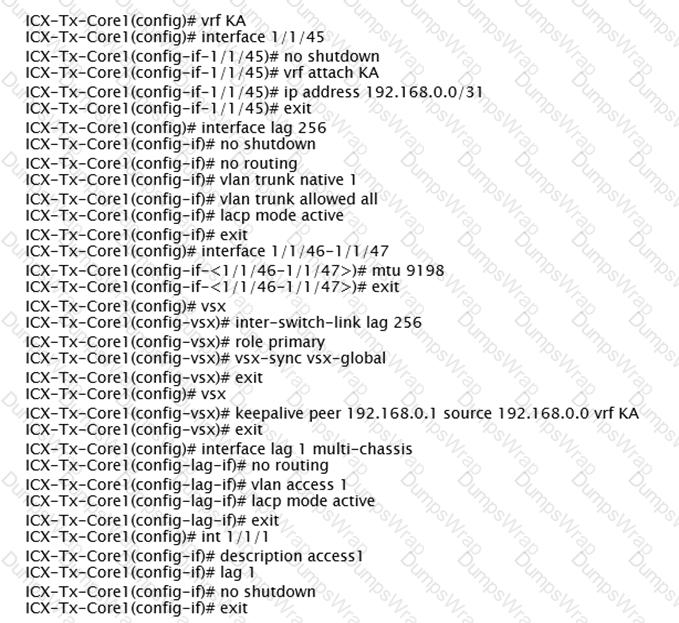
A network administrator is troubleshooting a connectivity issue involving the VSX LAG (link aggregation) between the core and access layer switch, during HW replacement of one of the core switches.
Which configuration should the administrator add to the core switch to fix this issue?
An administrator is managing a network comprised of AOS-CX switches deployed at the aggregation layer. The switches are paired in a VSX stack and run the OSPF routing protocol. The administrator is concerned about how long it takes for OSPF to converge when one of the VSX switches has to reboot.
What should the administrator to do speed up the OSPF convergence of the switch that is rebooting?
What is correct regarding rate limiting and egress queue shaping on AOS-CX switches?
What is correct regarding rate limiting and egress queue shaping on AOS-CX switches?
A network administrator needs to replace an antiquated access layer solution with a modular solution involving AOS-CX switches. The administrator wants to leverage virtual switching technologies. The solution needs to support high-availability with dual-control planes.
Which solution should the administrator implement?
Examine the following AOS-CX switch configuration:

Which access control entries would allow web traffic to the web servers 10.1.0.100 and 10.1.1.100?
An access layer AOS-CX has no OoS configuration on it. The switch receives an 802.1Q tagged VoIP frame on a port. The frame has an 802.1p value of 6. The IP header has a DSCP value of EF46 How will the switch forward this frame?
Examine the AOS-CX configuration:
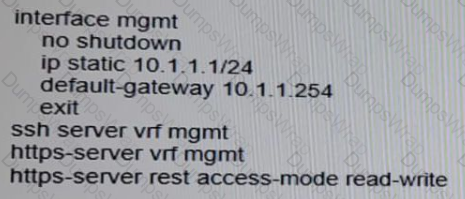
The switches have a default factory password setting NetEdit fails to access the configuration of the AOS-CX switches. What should the administrator do to solve this problem?
Examine the following ACL rule policies:
Permit traffic from 10.2.2.1 through 10.2.2.30 to anywhere
Permit traffic from 10.2.2.40 through 10.2.2.55 to anywhere
Deny all others
Based on this policy, place the following ACL rule statements in the correct order to accomplish the above
filtering policy.
What is the purpose of the transit VLAN when implementing dynamic segmentation policies involving AOS-CX switches and an Aruba gateway solution?
An administrator of a company has concerns about upgrading the access layer switches. The users rely
heavily on wireless and VoIP telephony. Which is the best recommendation to ensure a short downtime for the users during upgrading the access layer switches?
An administrator wants to use an existing Aruba gateway's firewall policies to filter both wireless and wired traffic. Which AOS-CX switch feature should a customer implement to ensure the gateway applies the same or similar firewall policies to users' wired and wireless traffic?
An administrator has an aggregation layer of 8325CX switches configured as a VSX pair. The administrator is
concerned that when OSPF network changes occur, the aggregation switches will respond to the changes
slowly, and this will affect network connectivity, especially VoIP calls, in the connected access layer switches.
What should the administrator do on the aggregation layer switches to alleviate this issue?D18912E1457D5D1DDCBD40AB3BF70D5D
An administrator creates an ACL rule with both the “count” and “log” option enabled. What is correct about the
action taken by an AOS-CX switch when there is a match on this rule?
An administrator is replacing the current access switches with AOS-CX switches. The access layer switches
must authenticate user and networking devices connecting to them. Some devices support no form of
authentication, and some support 802.1X. Some ports have a VoIP phone and a PC connected to the same
port, where the PC is connected to the data port of the phone and the phone’s LAN port is connected to the switch.
Which statement is correct about this situation?
Examine the network exhibit.
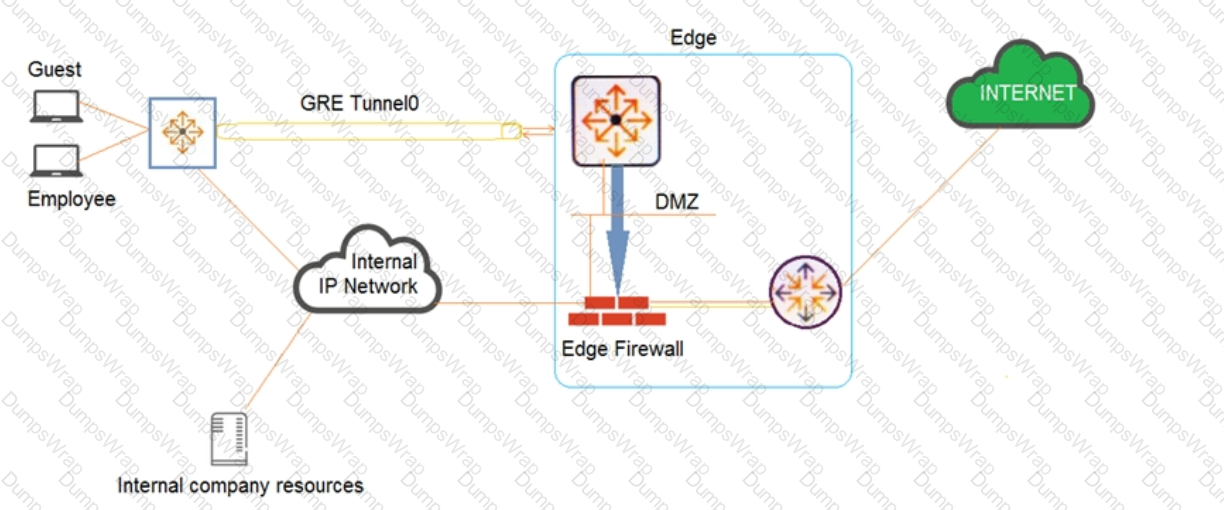
A company has a guest implementation for wireless and wired access. Wireless access is implemented
through a third-party vendor. The company is concerned about wired guest traffic traversing the same network as the employee traffic. The network administrator has established a GRE tunnel between AOS-CX switches where guests are connected to a routing switch in the DMZ.
Which feature should the administrator implement to ensure that the guest traffic is tunneled to the DMZ while the employee traffic is forwarded using OSPF?
The AOS-CX mobile app allows a network engineer or technician to perform which tasks? (Choose two.)
What is correct regarding policy-based routing?
A network has an ABR that connects area 0 and 1. A network engineer configures a summarized route for area 0. The ABR is a designated router (DR) for the segment it uses to connect to area 1.
Which LSA type is assigned to this route when the summarized route is advertised into area 1 by the ABR?
An administrator implements interim accounting for guest users so that ClearPass can track the amount of bandwidth that guests upload and download. Guests that abuse bandwidth consumption should be disconnected from the network. The administrator configures the following on the AOS-CX access switches:

After performing this configuration, the administrator notices that guest users that have exceeded the guest bandwidth limit are not being disconnected. Upon further investigation, Access Tracker in ClearPass indicates a disconnect CoA message is being sent to the AOS-CX switch.
What is causing this issue?

